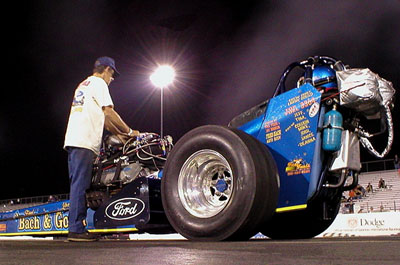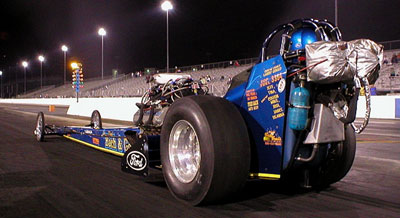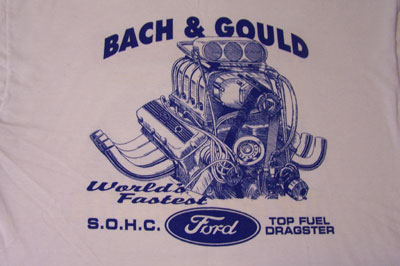

Your turn
One of the greatest things about this column – other than getting to dig elbows deep into drag racing history and reconnecting with heroes past who stunningly discover that we still remember them – is the exchange of information between me and the readers. Rare is the column that goes by without a note or two fleshing out (and sometimes correcting!) long-lost details I have unearthed or merely sharing memories or thoughts. It has been my thrill many times to actually hear from those featured herein, racers whom I had never spoken to or, in some cases, heard of before writing about them.
I keep a running folder of such correspondence and empty it out every now and then. Today is one of those "nows."
 Bret Kepner passed along this trio of photos he shot during a test-n-tune event in September 2003, when Larry Gould and partner Fred Bach showed up to "try out some ideas" on their SOHC Ford nostalgia AA/FD. "This photo shows Larry and his son (an accomplished oval track racer who grew up thrashing under a blown fuel Cammer), walking Freddie back from the burnout." |
 "This picture shows Larry doing what Larry was meant to do; he's simply standing next to an idling Cammer adjusting the barrel valve to what he could hear and feel was the proper setting. Larry is infamous for his almost-catatonic laid-back starting-line ritual. Without frantic running or frenzied rushed movements, he would calmly fire the car, back up his driver, make fuel-system adjustments, and, with an almost uninterested facial expression, guide the car into the beams. He may as well have been watching the evening news on TV." |
 "This photo shows Bach as he inched to the line before cranking out the quickest Ford-powered fuel run ever, a 6.23, before all of aÌýhundred street car spectators." |
 Reader John Schultz has been a Ford fan forever, especially of the blown nitro-burning 427 SOHC. He got a Gould & Bach T-shirt at his local track in Wisconsin when the team appeared there. "I was not familiar with Larry at the time, but my eyes got real big as I gazed upon his 427 SOHC motor in the pits," he wrote. |
 |
I keep in regular contact with Bret Kepner, surely one of the most knowledgeable among us drag racing historians. He's always able to add a detail or two about some of my subjects and couldn’t resist a more detailed addition to my information on Ford Cammer enthusiast Larry Gould, as shown in .
"I was pleased to see a mention of Larry Gould. Here are a few facts about one of the most focused, hard-core humans I've met.
Ìý
"Gould's first flopper was actually an ex-Nicholson '68 Cougar purchased from Sid Foster/Larry Coleman. When he blew the body off at an East Coast match race, the only replacement available on short notice was a '71 Charger, which he had painted to bear the name Trojan Horse, (complete with a beautiful mural), referencing the hidden SOHC Ford in Dodge clothing. The Charger eventually ran a 6.52, 236.22 at New York National Speedway in '75 for a factory-block Ford speed record that stands to this day.
"Gould later campaigned a gorgeous red-on-white '73 Mach I, which remained in action until the blue/flamed Mustang II debuted in '78. That car was raced continually until the EXP debuted at the 1982 AHRA Gateway Nationals at St. Louis, where, with immaculate black paint still tacky, the new ride sailed off the end of the old SLIR with no parachutes on its first run.
Ìý
"The EXP debuted with Cammer power and, after repairs, stayed that way until the 1986 season, when Larry teamed with Floridian Al Herring and put a KB Hemi in the chassis. The duo was more competitive than ever, (mostly in IHRA competition) and maintained the same match race schedule Larry had kept since the late '60s. Gould was infamous for booking dates at very, very small tracks east of the Rockies; he honestly enjoyed the backwoods facilities over the modern strips. I remember he anxiously awaited his annual date at Green Valley Raceway in Gadsden, Ala., telling me in the late '70s, 'Every time I go down there, it's like the crowd has never seen a fuel Funny Car before!'Ìý
Ìý
"Larry still owned the EXP when he started driving the Wade/Youngblood American Dream Cutlass. In fact, the Mustang II is still around now competing on the nostalgia Funny Car circuit. He still lives in the St. Louis suburb of Belleville, Ill., a stone's throw from the 61-year-old Belle-Clair Speedway dirt oval at which he has always campaigned a circle-burner even throughout his drag racing career. As you may have expected, all his stock cars have been Ford-powered and Ford-bodied, too.
Ìý
"Gould's racing career is extensive, but he will forever be known as one of the most determined Ford fanatics and most inventive 'backyard engineers' in the sport's history. He was enamored with the SOHC engine since its debut and spent the majority of his career refining the concept with his own innovations, including replacing the engine's complicated chain-drive internals with a gear-drive configuration of his own and revising the powerplant's electrical system all the way to moving the distributor/magneto location.
Ìý
"Throughout most of his life, he has searched for and acquired every SOHC motor produced and eventually owned almost all of them. He began casting his own heads and blocks in aluminum using a foundry he built in his backyard. He remains not only the owner of most of the surviving SOHC engines and paraphernalia but also the most knowledgable human ever to run one of 'em on nitro. Anybody who has ever met Larry Gould will always envision him, with his ever-present cup of hot coffee in hand, working on, talking about, or developing new ideas for the Ford Cammer."

And yet another from the G drawer. "Paul Gentilozzi’s old D/Gas Arrow is alive and well, and my father, Dennis Buckley, has been bracket racing the car for the last 12 years now," wrote Scott Buckley. "The little Plymouth has retained all of its original Wayne Farr chassis and red anodized tinwork but was updated with an early '80s grille and headlights by a previous owner. Paul Gentilozzi and Wayne Farr verified the authenticity of the car at a Trans Am Series race at Road America about eight years ago. Paul told us that he had the car constructed when he was the technical editor for Popular Hot Rodding magazine after doing an in-depth feature on Glidden’s Pro Stock Arrow. Paul was first in line to purchase Glidden’s car when Ford renewed Bob’s Pro Stock sponsorship, so he sold the red Arrow to a fellow Super Gas racer in Kentucky (after removing the manual trans and installing a Powerglide), and it eventually wound up in Nebraska, where my father purchased it 12 years ago. The old Arrow is still very consistent, and Dad won the Super Pro category at the Drag News Shootout a few years ago and also had a runner-up finish at the Fall Bracket Nationals. The old Plymouth Arrow is in the Madison, Wis., area now."
 |
Ìý

Ah, the love for "the Snake" just goes on and on here at the Insider. Phil Claypool passed along the two photos below of his copy of Hal Higdon's book on Prudhomme, Six Seconds to Glory. "I got Don to autograph it at Sacramento Raceway soon after it was published. I had taped a news article to it also. A great memory." I, too, remember the book, though I never owned a copy. I do remember though that either Drag Racing USA or Super Stock & Drag Illustrated serialized it in their magazine for several months, so I did get to read it.
 |

 |
John Totten passed along the great pic at right that he calls "Two Dons," featuring "Big Daddy" Don Garlits and Prudhomme. "A friend and I had the opportunity to attend the 1973 and '74 Springnationals at National Trail," he remembered. "To get the use of my sister's little 110 camera, I had to take along my 13-year-old kid brother. Wow, was it worth it as I now have a binder of the photos I took. My 49-year-old 'kid brother' now has programs from both years full of autographs as well as racers' handouts.
Ìý
"This is my favorite photo of Prudhomme and Garlits. The Dayton papers were really writing about how much the two disliked each other. This photo was taken the day after the article. I couldn't tell you what the conversation was about as I was in awe."
"Thanks for your articles. They really bring back a lot of good memories. My favorite racers have now passed on. Dan Geare, Dean LaPole, and Fred Totten, the owners and builders of the King Camaro Funny Car -- Chevrolet-powered with some of the first Arias heads. Fred was my cousin, and we would spend hours long distance talking about racing in the past and present."

Rick Kirkpatrick wrote, "Phil, I have read your articles since day one, and you or Bob Frey would know the answer. Everyone else I talked to thinks I'm nuts. I have followed and participated in drag racing since 1963. I was 16 in 1967. I think in the late '60s, some fuel teams were experimenting with a 180-degree crank. I know they dropped the program. Am I correct in assuming that they wanted to fire two cylinders at once? I remember hearing and reading about it but cannot recall what it was about. Either a yep or a nope would answer my question. Thanks."
I wasn't sure whom Rick might have been remembering from the 1960s, but I did know that Gary Beck has experimented with a 180 crank more recently, so I dropped his good pal Henry Walther a note along with Rick's e-mail. His response:
"Gary Beck tried a 180-degree crank in 1977 or 1978. That was before I joined him. It was a short-lived experiment. The idea behind the 180 crank wasn’t to fire two cylinders at once, although that could have been done. There were two other reasons that prompted its use.
"The first was to try to lessen the load on the No. 2 and No. 4 main journals, which during that time frame was a big problem with the late-model Hemi. The 180 crank did take the load off of No. 2 and No. 4, but it transferred it to No. 3. As you know, the No. 3 journal in the 426 is the thrust bearing, and when it started taking a beating, that wasn’t a good trade-off. It was a tougher fix than the other journals.
"The second idea was that by using the 180 crank, you had a selection of firing orders that could be incorporated. Keith Black had a favorite firing order for use with the ‘flat’ crank that would prevent two cylinders, whose intake ports were close to each other, from firing one after the other and thereby robbing the second firing cylinder of air/fuel. In theory, this would help even out the distribution in the intake manifold. If it could do that, then there was a potential gain in performance to be had.
"Unfortunately, there was no performance gain ever realized, and the cost of repairing blocks increased, so the 180-degree crank was soon relegated to the ‘another bright idea’ bin."

"Berserko Bob" Doerrer had a note to add to the NHRA chronology from the , in reference to the 1962 introduction of the first traction-mix compound for dragstrip asphalt by NHRA and Shell Oil. Reports B.B., "It was called Plio-Pave, and Vinnie Napp used it when Raceway Park was repaved in the spring of 1968 before the Springnationals. The issue was that it took the mix a long time to cure and was very soft. We spent many days putting water on the surface to help it cure. It eventually came around, but for a few weeks, Vinnie was sweating it out."

And finally, there's this.ÌýJeff Mittendorf has a huge "Snake" and "Mongoose" fan/memorabilia collection and passed along a link to photos of the "fully functional/fully landscaped 1/43-scale dragstrip" in his home. "It was created to resemble an early 1970s dragstrip," he wrote. "The Tree can do bracket or Pro countdown, and I measure r.t./e.t./mph just like NHRA does with sensors in the track, and those all show on the scoreboards. To get down the track, you actually have to shift the cars." You can see more details . Nice work, Jeff!
 |
Ìý




















































